
翻译:吴金笛
校对:和中华
学习如何开发一个自动生成音乐的端到端模型
理解WaveNet架构并使用Keras从零开始实现它
在建立自动音乐生成模型的同时,比较了WaveNet和Long-Short-Term Memory的性能

使用WaveNet架构
使用Long-Short-Term Memory(LSTM)

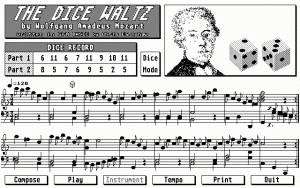
从头开始学习卷积神经网络(CNNs)的全面教程
深度学习要领:长短期记忆(LSTM)入门
学习序列建模的必读教程
音符:单键发出的声音称为音符
和弦:由两个或更多的键同时发出的声音称为和弦。一般来说,大多数和弦包含至少3个键音
八度:重复的模式称为八度。每个八度包含7个白键和5个黑键
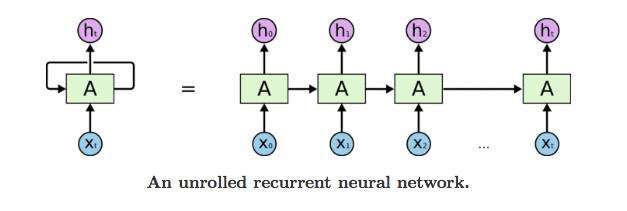

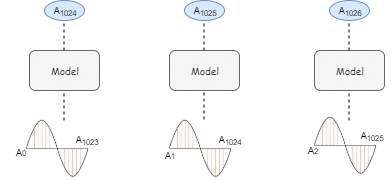
前3个块的输入和输出

卷积神经网络(CNNs)结构的解密
https://www.analyticsvidhya.com/blog/2017/06/architecture-of-convolutional-neural-networks-simplified-demystified/?utm_source=blog&utm_medium=how-to-perform-automatic-music-generation
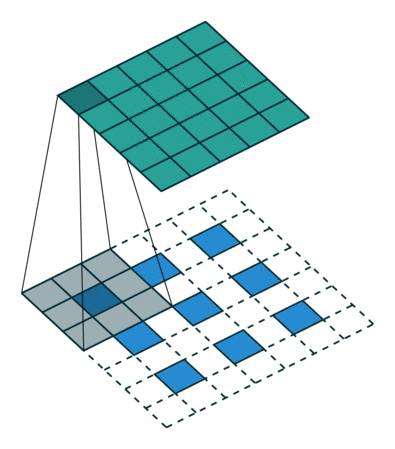
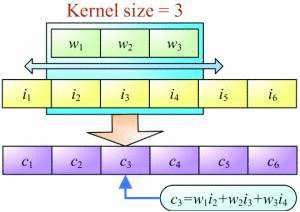
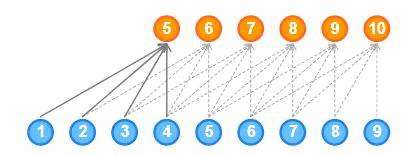
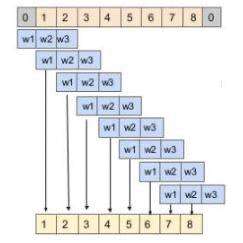
捕获输入序列中出现的序列信息
与GRU或LSTM相比,训练的速度要快得多,因为它们没有循环性的连接
当填充设置为same时,在时间步长t处的输出也与之前的t-1和未来的时间步长t+1进行卷积。因此,它违反了自回归原则
当填充被设置为valid时,输入和输出序列的长度会发生变化,这是计算残差连接所需要的(后面会讲到)

因果卷积没有考虑未来的时间步长,而这是建立生成模型的一个标准
因果卷积不能回溯到序列中过去发生的时间步长。因此,因果卷积的接受域非常低。网络的接受域是指影响输出的输入数量:
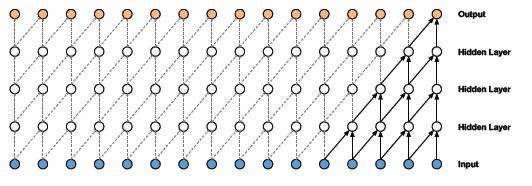

扩张的一维卷积网络通过指数增加每一隐藏层的扩张率来增加接受域:
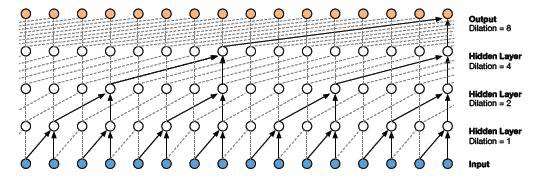
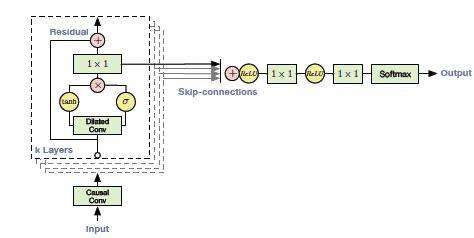
输入进入一个因果一维卷积
输出然后进入到2个不同的扩张一维卷积层并使用sigmoid和tanh激活
两个不同激活值逐元素相乘导致跳跃连接
而跳跃连接和因果一维输出的逐元素相加会导致残差
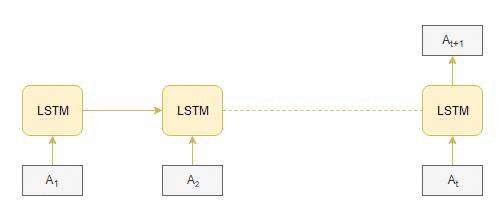
捕获输入序列中出现的顺序信息
由于它是按顺序处理输入信息的,所以它在训练上会花费大量的时间
(https://drive.google.com/file/d/1qnQVK17DNVkU19MgVA4Vg88zRDvwCRXw/view)
1. #library for understanding music 2. from music21 import *
1. #defining function to read MIDI files 2. def read_midi(file): 3. 4. print("Loading Music File:",file) 5. 6. notes=[] 7. notes_to_parse = None 8. 9. #parsing a midi file 10. midi = converter.parse(file) 11. 12. #grouping based on different instruments 13. s2 = instrument.partitionByInstrument(midi) 14. 15. #Looping over all the instruments 16. for part in s2.parts: 17. 18. #select elements of only piano 19. if 'Piano' in str(part): 20. 21. notes_to_parse = part.recurse() 22. 23. #finding whether a particular element is note or a chord 24. for element in notes_to_parse: 25. 26. #note 27. if isinstance(element, note.Note): 28. notes.append(str(element.pitch)) 29. 30. #chord 31. elif isinstance(element, chord.Chord): 32. notes.append('.'.join(str(n) for n in element.normalOrder)) 33. 34. return np.array(notes)
1. #for listing down the file names 2. import os 3. 4. #Array Processing 5. import numpy as np 6. 7. #specify the path 8. path='schubert/' 9. 10. #read all the filenames 11. files=[i for i in os.listdir(path) if i.endswith(".mid")] 12. 13. #reading each midi file 14. notes_array = np.array([read_midi(path+i) for i in files])
1. #converting 2D array into 1D array 2. notes_ = [element for note_ in notes_array for element in note_] 3. 4. #No. of unique notes 5. unique_notes = list(set(notes_)) 6. print(len(unique_notes))
1. #importing library 2. from collections import Counter 3. 4. #computing frequency of each note 5. freq = dict(Counter(notes_)) 6. 7. #library for visualiation 8. import matplotlib.pyplot as plt 9. 10. #consider only the frequencies 11. no=[count for _,count in freq.items()] 12. 13. #set the figure size 14. plt.figure(figsize=(5,5)) 15. 16. #plot 17. plt.hist(no)
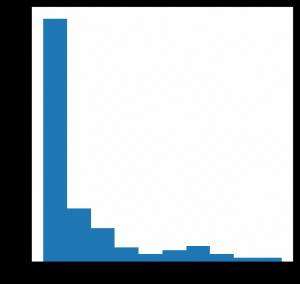
1. frequent_notes = [note_ for note_, count in freq.items() if count>=50] 2. print(len(frequent_notes))
1. new_music=[] 2. 3. for notes in notes_array: 4. temp=[] 5. for note_ in notes: 6. if note_ in frequent_notes: 7. temp.append(note_) 8. new_music.append(temp) 9. 10. new_music = np.array(new_music)
1. no_of_timesteps = 32 2. x = [] 3. y = [] 4. 5. for note_ in new_music: 6. for i in range(0, len(note_) - no_of_timesteps, 1): 7. 8. #preparing input and output sequences 9. input_ = note_[i:i + no_of_timesteps] 10. output = note_[i + no_of_timesteps] 11. 12. x.append(input_) 13. y.append(output) 14. 15. x=np.array(x) 16. y=np.array(y)
1. unique_x = list(set(x.ravel())) 2. x_note_to_int = dict((note_, number) for number, note_ in enumerate(unique_x))
1. #preparing input sequences 2. x_seq=[] 3. for i in x: 4. temp=[] 5. for j in i: 6. #assigning unique integer to every note 7. temp.append(x_note_to_int[j]) 8. x_seq.append(temp) 9. 10. x_seq = np.array(x_seq)
1. unique_y = list(set(y)) 2. y_note_to_int = dict((note_, number) for number, note_ in enumerate(unique_y)) 3. y_seq=np.array([y_note_to_int[i] for i in y])
1. from sklearn.model_selection import train_test_split 2. x_tr, x_val, y_tr, y_val = train_test_split(x_seq,y_seq,test_size=0.2,random_state=0)
1. def lstm(): 2. model = Sequential() 3. model.add(LSTM(128,return_sequences=True)) 4. model.add(LSTM(128)) 5. model.add(Dense(256)) 6. model.add(Activation('relu')) 7. model.add(Dense(n_vocab)) 8. model.add(Activation('softmax')) 9. model.compile(loss='sparse_categorical_crossentropy', optimizer='adam') 10. return model
1. from keras.layers import * 2. from keras.models import * 3. from keras.callbacks import * 4. import keras.backend as K 5. 6. K.clear_session() 7. model = Sequential() 8. 9. #embedding layer 10. model.add(Embedding(len(unique_x), 100, input_length=32,trainable=True)) 11. 12. model.add(Conv1D(64,3, padding='causal',activation='relu')) 13. model.add(Dropout(0.2)) 14. model.add(MaxPool1D(2)) 15. 16. model.add(Conv1D(128,3,activation='relu',dilation_rate=2,padding='causal')) 17. model.add(Dropout(0.2)) 18. model.add(MaxPool1D(2)) 19. 20. model.add(Conv1D(256,3,activation='relu',dilation_rate=4,padding='causal')) 21. model.add(Dropout(0.2)) 22. model.add(MaxPool1D(2)) 23. 24. #model.add(Conv1D(256,5,activation='relu')) 25. model.add(GlobalMaxPool1D()) 26. 27. model.add(Dense(256, activation='relu')) 28. model.add(Dense(len(unique_y), activation='softmax')) 29. 30. model.compile(loss='sparse_categorical_crossentropy', optimizer='adam') 31. 32. model.summary()
mc=ModelCheckpoint('best_model.h5', mOnitor='val_loss', mode='min', save_best_Only=True,verbose=1)
1. #loading best model 2. from keras.models import load_model 3. model = load_model('best_model.h5')
1. import random 2. ind = np.random.randint(0,len(x_val)-1) 3. 4. random_music = x_val[ind] 5. 6. predictiOns=[] 7. for i in range(10): 8. 9. random_music = random_music.reshape(1,no_of_timesteps) 10. 11. prob = model.predict(random_music)[0] 12. y_pred= np.argmax(prob,axis=0) 13. predictions.append(y_pred) 14. 15. random_music = np.insert(random_music[0],len(random_music[0]),y_pred) 16. random_music = random_music[1:] 17. 18. print(predictions)
1. x_int_to_note = dict((number, note_) for number, note_ in enumerate(unique_x)) 2. predicted_notes = [x_int_to_note[i] for i in predictions]
1. def convert_to_midi(prediction_output): 2. 3. offset = 0 4. output_notes = [] 5. 6. # create note and chord objects based on the values generated by the model 7. for pattern in prediction_output: 8. 9. # pattern is a chord 10. if ('.' in pattern) or pattern.isdigit(): 11. notes_in_chord = pattern.split('.') 12. notes = [] 13. for current_note in notes_in_chord: 14. 15. cn=int(current_note) 16. new_note = note.Note(cn) 17. new_note.storedInstrument = instrument.Piano() 18. notes.append(new_note) 19. 20. new_chord = chord.Chord(notes) 21. new_chord.offset = offset 22. output_notes.append(new_chord) 23. 24. # pattern is a note 25. else: 26. 27. new_note = note.Note(pattern) 28. new_note.offset = offset 29. new_note.storedInstrument = instrument.Piano() 30. output_notes.append(new_note) 31. 32. # increase offset each iteration so that notes do not stack 33. offset += 1 34. midi_stream = stream.Stream(output_notes) 35. midi_stream.write('midi', fp='music.mid')
convert_to_midi(predicted_notes)
由于训练数据集的规模较小,我们可以对预训练的模型进行微调,以建立一个鲁棒的系统
尽可能多地收集训练数据,因为深度学习模型在更大的数据集上泛化更好
原文链接:
https://www.analyticsvidhya.com/blog/2020/01/how-to-perform-automatic-music-generation/
原文题目:
Want to Generate your own Music using Deep Learning? Here’s a Guide to do just that!
译者简介
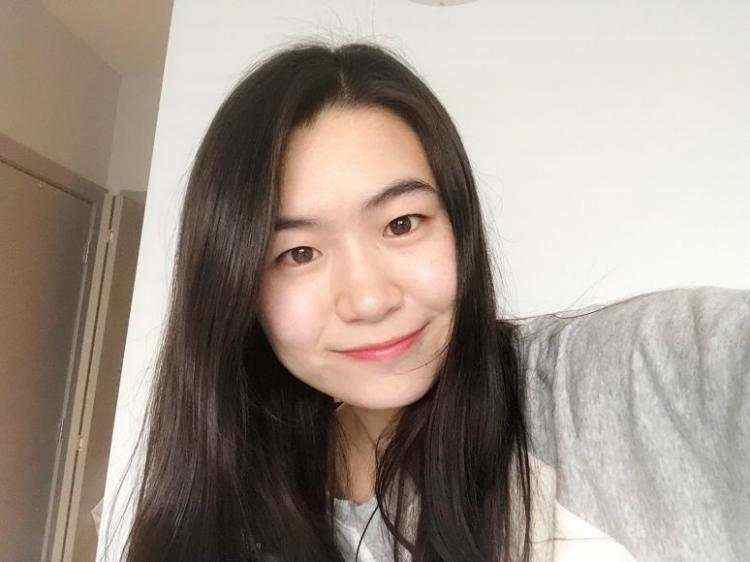
翻译组招募信息
工作内容:需要一颗细致的心,将选取好的外文文章翻译成流畅的中文。如果你是数据科学/统计学/计算机类的留学生,或在海外从事相关工作,或对自己外语水平有信心的朋友欢迎加入翻译小组。
你能得到:定期的翻译培训提高志愿者的翻译水平,提高对于数据科学前沿的认知,海外的朋友可以和国内技术应用发展保持联系,THU数据派产学研的背景为志愿者带来好的发展机遇。
其他福利:来自于名企的数据科学工作者,北大清华以及海外等名校学生他们都将成为你在翻译小组的伙伴。
点击文末“阅读原文”加入数据派团队~
转载须知
如需转载,请在开篇显著位置注明作者和出处(转自:数据派ID:DatapiTHU),并在文章结尾放置数据派醒目二维码。有原创标识文章,请发送【文章名称-待授权公众号名称及ID】至联系邮箱,申请白名单授权并按要求编辑。
发布后请将链接反馈至联系邮箱(见下方)。未经许可的转载以及改编者,我们将依法追究其法律责任。

点击“阅读原文”拥抱组织

 京公网安备 11010802041100号 | 京ICP备19059560号-4 | PHP1.CN 第一PHP社区 版权所有
京公网安备 11010802041100号 | 京ICP备19059560号-4 | PHP1.CN 第一PHP社区 版权所有